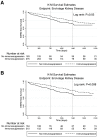Treatment with Glucocorticoids or Calcineurin Inhibitors in Primary FSGS
- PMID: 26912551
- PMCID: PMC4791818
- DOI: 10.2215/CJN.07110615
Treatment with Glucocorticoids or Calcineurin Inhibitors in Primary FSGS
Abstract
Background and objectives: In primary FSGS, calcineurin inhibitors have primarily been studied in patients deemed resistant to glucocorticoid therapy. Few data are available about their use early in the treatment of FSGS. We sought to estimate the association between choice of therapy and ESRD in primary FSGS.
Design, setting, participants, & measurements: We used an inception cohort of patients diagnosed with primary FSGS by kidney biopsy between 1980 and 2012. Factors associated with initiation of therapy were identified using logistic regression. Time-dependent Cox models were performed to compare time to ESRD between different therapies.
Results: In total, 458 patients were studied (173 treated with glucocorticoids alone, 90 treated with calcineurin inhibitors with or without glucocorticoids, 12 treated with other agents, and 183 not treated with immunosuppressives). Tip lesion variant, absence of severe renal dysfunction (eGFR≥30 ml/min per 1.73 m(2)), and hypoalbuminemia were associated with a higher likelihood of exposure to any immunosuppressive therapy. Only tip lesion was associated with initiation of glucocorticoids alone over calcineurin inhibitors. With adjusted Cox regression, immunosuppressive therapy with glucocorticoids and/or calcineurin inhibitors was associated with better renal survival than no immunosuppression (hazard ratio, 0.49; 95% confidence interval, 0.28 to 0.86). Calcineurin inhibitors with or without glucocorticoids were not significantly associated with a lower likelihood of ESRD compared with glucocorticoids alone (hazard ratio, 0.42; 95% confidence interval, 0.15 to 1.18).
Conclusions: The use of immunosuppressive therapy with calcineurin inhibitors and/or glucocorticoids as part of the early immunosuppressive regimen in primary FSGS was associated with improved renal outcome, but the superiority of calcineurin inhibitors over glucocorticoids alone remained unproven.
Keywords: ESRD; calcineurin inhibitors; focal segmental glomerulosclerosis; glomerular disease; glucocorticoids; humans; immunosuppression; immunosuppressive agents; nephrotic syndrome.
Copyright © 2016 by the American Society of Nephrology.
Figures




Comment in
-
Rethinking First-Line Immunosuppression for Idiopathic FSGS.Clin J Am Soc Nephrol. 2016 Mar 7;11(3):372-3. doi: 10.2215/CJN.00780116. Epub 2016 Feb 16. Clin J Am Soc Nephrol. 2016. PMID: 26912552 Free PMC article. No abstract available.
References
-
- Haas M, Meehan SM, Karrison TG, Spargo BH: Changing etiologies of unexplained adult nephrotic syndrome: A comparison of renal biopsy findings from 1976-1979 and 1995-1997. Am J Kidney Dis 30: 621–631, 1997 - PubMed
-
- Kitiyakara C, Eggers P, Kopp JB: Twenty-one-year trend in ESRD due to focal segmental glomerulosclerosis in the United States. Am J Kidney Dis 44: 815–825, 2004 - PubMed
-
- D’Agati VD, Kaskel FJ, Falk RJ: Focal segmental glomerulosclerosis. N Engl J Med 365: 2398–2411, 2011 - PubMed
-
- Korbet SM, Schwartz MM, Lewis EJ: Primary focal segmental glomerulosclerosis: Clinical course and response to therapy. Am J Kidney Dis 23: 773–783, 1994 - PubMed
-
- Banfi G, Moriggi M, Sabadini E, Fellin G, D’Amico G, Ponticelli C: The impact of prolonged immunosuppression on the outcome of idiopathic focal-segmental glomerulosclerosis with nephrotic syndrome in adults. A collaborative retrospective study. Clin Nephrol 36: 53–59, 1991 - PubMed
Publication types
MeSH terms
Substances
LinkOut - more resources
Full Text Sources
Other Literature Sources
Medical

